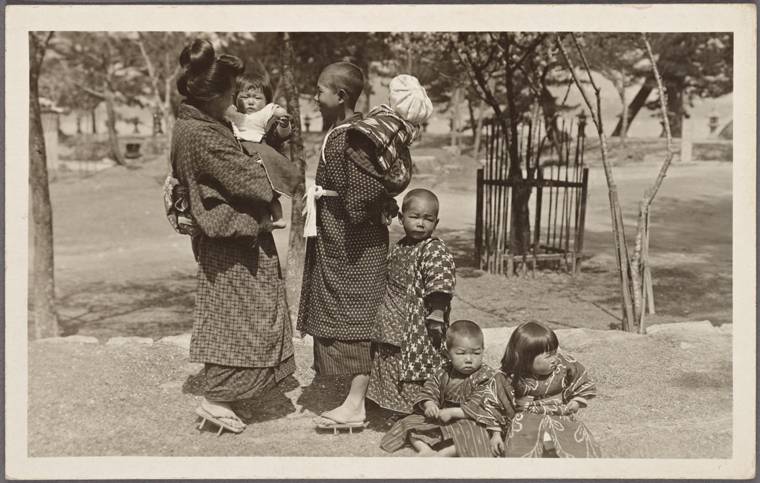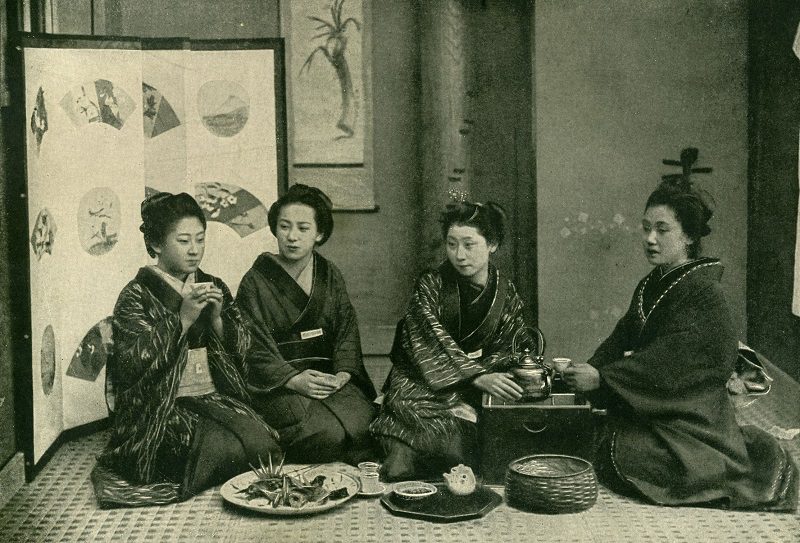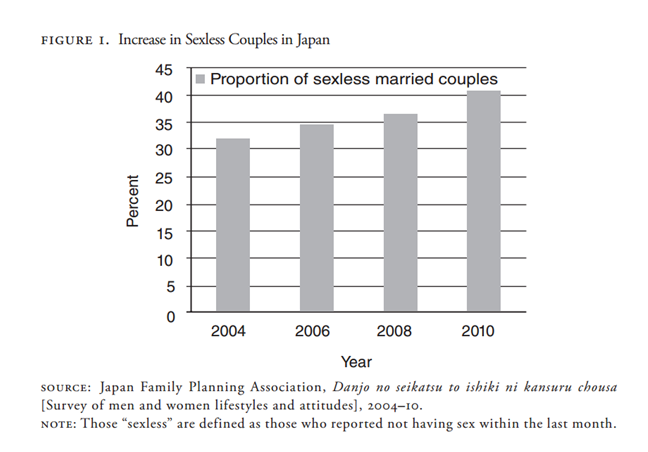Birthrates in the developed world, especially in South Korea and Japan, have fallen below the replacement rate. Japan’s total fertility rate dropped below replacement back in 1974 with population decline beginning in 2010 (Oizimi, 2022). Japan’s population also declines because of people migrating out of the country. This has led to concern about demographic collapse, the point where the number of elderly who need financial support and care outstrips the number of younger people who are able to work and support them. This may require entire societies to reorganize to handle these economic problems (Larsen, n.d.). For a society’s population to remain stable, couples need to give birth to a statistical 2.1 children to replace themselves and the account for people who don’t have children or have one child. This works out to some families having 3 or more children. The global total fertility rate hit 2.31 in 2019, declining from 4.97 in 1950. The decline appears in almost all countries, except for a few African countries (Pourreza, 2021). Population decline has some benefits: less environmental strain, more access to resources per individual, more land availability, and many others. But decline also means fewer people to work, possibly increasing the cost of goods and slowing innovation, fewer people to care for the elderly, increasing the number of disjointed far-flung communities, and increasing population density within cities.
Population decline has many different factor behind it, some cultural and others structural (Pourreza, 2021; Larsen, n.d.):
- Decline in marriage interest
- Work-related migration
- Reduced interest among young people in founding families
- Changes in norms surrounding parenting and child-rearing
- Increased costs in raising a child
- Increased living expenses (inflation)
- Increased housing costs
- Later marriages
- Improved living standards
- Increases in female education and income levels
- Increase in levels of young male virginity
The education and income levels of women link to fewer births. Educated women often make more money than men while still desiring a higher-income mate. This shrinks her pool of options. Educated women also have fewer children and invest more resources in those children. Investment in education, in part because of these factors, strongly correlates with a decline in total fertility rate (Cheng, 2022). These improved living standards reduces the desire for mothers and children to seek or need men. Likewise, men who enjoy higher living standards don’t feel as need to seek a mate because he has more options for his time: hobbies, travel, and so on. Poverty tends to increase marriage rates because of the economic necessity. Higher-income people marry later, which decreases the fertility window and resulting in fewer children being born. High costs of living coupled with higher standards for living reduces the resources people have to spend on children while, at the same time, increasing the expectations of what resources children and parents should have. This combines with living standards leaving people somewhat satisfied, which decreases interest in founding families among young people. Why go through the headaches of marriage and children when you could use the time and funds for traveling, having fun, or doing something else fulfilling? These factors, along with an increase in religiosity among men, play into the rise of virginity among American men under 30. From 2008 to 2018, the rate rose from 8% to 27%. Over the past 20 years, past-year sexual inactivity among young men, especially low-income men, rose from 19% to 31%.
Narratives surrounding romance and marriage have also shifted. As Larsen writes: “Literature and other forms of fiction are evolutionary tools that disseminate and forge consensus around how pair-bonding should be understood and conducted.” When people stop caring about stories about marriage and child-rearing or those stories change, the understanding about relationships change. We still have many romance stories, but they present impossible ideals which reinforce the gap between reality and fiction. Romance makes individual emotions sacred. If you read old Japanese romance stories, while they have elements of fantasy, such as fox wives or the typical peasant-turn-noble narratives, they held more realism than our modern stories. Japanese stories often feature the hardships and blessings of children and end in death. During the European medieval period, narratives from the farming class encourage companionate love. Larsen explains:
Whether the couple had ever felt strong love for one another, or if such affect had long since burned out, was of minor importance –as were feelings they may harbor for others. Keeping one’s children alive required fidelity and pragmatism, not indulging one’s emotions. The late medieval and early modern environments required that most people resist their evolved impulses for serial pair-bonding and extrapair copulation.
Today, we experience confluent love, a type of love that sacralizes convenience and self-realization (Larsen):
People are viewed as reward-maximizing individuals who should pair up for as long as their emotions or pragmatic concern motivate them to do so (confluence: coming together). When a pair-bond no longer is beneficial, one moves on to singledom or the next bond.
Evolutionary psychologists discuss how humans have both polygamous and monogamous impulses. Some cultures and time periods reinforce one or the other. Humans appear to have a polygynous bias within farming societies. In other words, the rich had multiple wives. Polygyny encouraged warfare as low-status men, with little to lose, took risks to attract or find women. However, serial monogamy aligns with the female reproductive cycle within hunter-gatherer groups. Women within these groups would get pregnant every 3-4 years, when weaning finished. The child would then be raised by the community, freeing their parents to either renew their bond or seek a new pairing (Larsen, n.d.). Tribes throughout South America developed a partible paternity belief system. Within this system, a child has more than one father. The details and rules vary among tribes. The Curripaco, for instance, didn’t allow for secondary fatherhood except when paternity was shared between brothers. Other groups recognized the primary father as the man married to the mother with secondary fathers as men who had sex with the mother prior and during pregnancy. These cultures believed it took multiple men to create a child. All the fathers would then contribute resources to support the mother and child. To phrase this idea in modern slang, the primary fathers would be the “beta” males who are more supportive and providing while the secondary fathers would be the “chads” or “alpha” males who may be strong and attractive but are not reliable (Ellsworth, 2014). Ache men, when interviewed “sometimes mentioned that they wanted to club some men who had sex with their wives and that some co-fathers were despised.” But on the whole, co-fathers appear to get along well enough.
All of this points to how human sexuality is fluid and influenced by culture and narratives. As culture and narratives change, birthrates can change too. Population decline isn’t anything new. The ancient world saw little population growth thanks to high infant mortality, high mother mortality, disease, famine, war, and other variables. In response, ancient cultures created their own solutions for population decline.
But before we get into these solutions, I need to discuss the conclusions many people draw from the factors behind population decline. In short, many people look to how female selection processes–choosing high-income men and the relationship among female education and income with birthrates–and point to how female empowerment was a mistake. Others state women need to overcome their evolved hypergamous nature and mate with lower-income and lower-educated men. Both of these arguments may see governmental support as societies facing demographic collapse become desperate and more authoritarian in the process. Some societies may repeal or limit women’s income, education, and other freedoms. Others may enforce arranged marriages. Most likely, we will see tax penalties for singlehood, divorce, and childlessness and incentives for marriage and having children. Many societies already experiment with cash payments for having children. Punishing women becomes the focus of these conclusions because women are the biological gatekeepers of fertility. They have to bare the biological costs of bearing children. This is all nonsense, but this is a sadly probable direction.
Across the ancient world, the biological cost women pay for having children factored into various customs, narratives, and practices. In some cultures, rich men had multiple wives because of the high chance many wives and children would die due to complications of childbirth and early infancy diseases. Polygamy acted as a societal insurance policy. Partible paternity developed as an alternative solution among genetically isolated tribes. In these cases, warfare posed a major hazard along with decreased genetic diversity. Co-fathers who share mates, children, and resources decrease the risk for warfare, increases child survival, and increases genetic variance. Warfare also decreases because of wider male sexual access to women (Ellsworth, 2014). Ancient societies learned that a population of sexually frustrated, risk-taking young men wasn’t good for stability. In polygamous societies this meant sending men off to war so they could find mates, which increased genetic diversity, or die, eliminating the instability problem. Arranged marriages, which ensured all men and women were pair-bonded, eased this risk as long as the ratio of men and women were close to equal. Arranged marriages focused on increasing resource availability among both families, helping with child survival and both family’s social status. Marriage has long been, and still is, a help for poverty. On the darker side, women often became property of husbands, having no social standing of their own, in order to guarantee the paternity of her children. This became especially important for societies which had birth-order inheritance systems.
Most ancient societies used a hybrid of arrange marriages to ensure paternity while ensuring women had some rights. During some periods of Roman history, for example, women could own businesses, property, and pass those resources down to her children if her husband was deceased. The Lenape, a Native American tribe, had matrilinear clan inheritance. Women controlled land use after the chief assigned that land to them following a tribal migration. Women could then refuse or allow people to hunt or farm her land parcels.
Japan’s Heian period developed its own solution, at least among the aristocracy, to encourage procreation. Under the Heian system, women owned property while men controlled income. This forced them together. Women needed income to maintain their property, and men needed a place to sleep. This created arrangements where women had several lovers, and so different income streams, similar to partible paternity. The lower classes practiced arranged marriage along with some love marriages. During the Edo period, marriages sometimes had a 1-year “trial” period where if the relationships, mostly between the wife and her mother-in-law, didn’t work out, the wife would return to her family with no stigma attached.
History offers many other variations of marriage, pair-bonding, arranged marriages, and even polyandry or some variation of it. All of these practices aimed at creating artificial needs which encouraged pair-bonding, such as the case of the Heian period, or meeting existing resource scarcity. For most societies, women experienced resource scarcity because of the nature of biology. Children are expensive biologically, and pregnancy hampered hunting (and yes, women did hunt) and other resource gathering. Even today having children damages a woman’s income level. But an increasing number of women now have more resources than men. The roles have reversed. This reversal is part of the reason why you can encounter vitriol against women and favor toward draconian measures among some segments of people. Not all problems need intervention, however. Population decline will eventually stabilize at a more sustainable level, but the transition could be a problem for the world’s economy. The pressure this transition will cause will probably lead to some sort of intervention.
What interventions are the most viable or least painful?
For the record, I prefer no direct intervention and allow the population decline to naturally resolve itself. Any direct societal intervention would require some group to give up a subset of rights to artificially create pair-bonding or some other resource contribution system. The best societal intervention would be to support men with similar education, job, and economic assistance which led to women’s progress. This wouldn’t take anything from women, but such a solution wouldn’t be as visible, and let’s face it, we live in a visible “now” age. People can’t wait decades for results without some sort of “improvement” signalling itself. For this thought exercise, I’m focused on heterosexual couples because their bonds result in children. The ancient world’s solutions might offer a framework for some sort of modern intervention. Partible paternity wouldn’t work with paternity tests; men won’t be willing to help pay for a child just because they had sex with the child’s mother. Arranged marriages with contracts which need to be renewed every, say 5 or 10 years, may prove viable. First, arranged marriages can match people based on interests, values, economic level, and other traits. A contract which lasts a set period of time provides a means of “divorce” which can be regulated for stability. It recognizes the already temporary nature of modern relationships and marriages. Think of it as a prenuptial with children and other factors written into the contract. And then this contract, should it be renewed, can be renegotiated. This may eliminate the romantic element of relationships and pair-bonding, but romance is a relatively recent experiment in human history. This sort of contract draws on the Japanese “trial marriage” system of the Edo period.
A more heavy-handed method might be an inverse of the Heian period. In this, admitted authoritarian system, women are barred from owning property while men are barred from having income streams. This artificial scarcity would require property to be distributed to men whose income streams would be owned by their wives or mothers or some other female figure. Women wouldn’t be allowed to rent or own property. This would artificially force women and men together through income and homelessness. This sort of system would be dystopian, to put it mildly. Even if the system followed the one in the Heian period, with women owning land and men barred from owning it, it would remain dystopian. Under either system, income-generating assets would also have to be limited to one group or the other. Freedom and choice would disappear.
Of these thought experiments, the arranged marriage contract system might prove the most viable. It is more equitable, assuming it uses a matchmaking method, with how it affects men and women and limited with the temporary nature of the contract. Some anime have even played with this idea. But no matter what system you consider, society–whether handled through a citizen council, matchmakers, or the government–would be meddling in something that is intensely personal. This is why I favor no intervention or educational and employment assistance as solutions for the population decline problem. I’m not convinced population decline is a problem. The speed of it may be, but decline itself may not be. After the population decline of the Black Death, Europe saw a blossoming of innovation, ideas, and art which lay the foundation for the Enlightenment and modern society. Other population collapses in history have seen similar flowering afterwards, and, ultimately, an increase in population above the levels before the collapse.
Japan and South Korea lead in this decline, meaning they will also lead in whatever flowering happens afterward. I jokingly say all Japan needs to do is encourage a weeb migration, and all South Korea needs to do is open itself to all the female K-pop fans and tell the singers to get busy. Boom! Problems solved. But in all seriousness, population decline will lead to cultural and societal changes as they had throughout history. What Japan and South Korea face may be different compared to other points in history. At least with the extreme levels of decline both countries experience. But I suspect this population decline is just another historical pattern. It’s appears worse because of the large numbers involved and how decline is measured. In the past, decline was only understood in retrospect. Now, we can model it with reasonable accuracy in real time. I doubt South Korea or Japan will disappear, but their cultures will change. Likely, they will become more encouraging of immigration. Japan may simplify its writing system to accommodate those immigrants similar to how it did during the Meiji Restoration and the influx of Westerners it brought. We are living in a transition point in history, and it will, most likely, follow already historical patterns. We won’t know for sure until we get through this transition period and can look back on it.
References
Cheng, H., Luo, W., Si, S., Xin, X., Peng, Z., Zhou, H., Liu, H., & Yu, Y. (2022). Global trends in total fertility rate and its relation to national wealth, life expectancy and female education. BMC Public Health, 22(1), 1–13. https://doi-org.oh0164.oplin.org/10.1186/s12889-022-13656-1
Ellsworth, R.M. (2014). Partible paternity and human reproductive behavior. Submitted by the University of Missouri–Columbia Graduate School.
Larsen, Mads. Pair-Bonding: In Human Evolution. Encyclopedia of Sexual Psychology and Behavior. doi:10.1007/978-3-031-08956-5_1684-1
Oizumi, R., Inaba, H., Takada, T., Enatsu, Y., & Kinjo, K. (2022). Sensitivity analysis on the declining population in Japan: Effects of prefecture-specific fertility and interregional migration. PLoS ONE, 17(9), 1–23. https://doi-org.oh0164.oplin.org/10.1371/journal.pone.0273817
Pourreza, A., Sadeghi, A., Amini-Rarani, M., Khodayari-Zarnaq, R., & Jafari, H. (2021). Contributing factors to the total fertility rate declining trend in the Middle East and North Africa: a systemic review. Journal of Health, Population & Nutrition, 40(1), 1–7. https://doi-org.oh0164.oplin.org/10.1186/s41043-021-00239-w








Well written and thorough article. But I have to ask, is there necessarily a long-term benefit to increasing, or even stabilizing Japan’s population through increased fertility rates? I know the short term arguments. But at what point does a growth-model become unsustainable? And do we really want to perpetuate the cultural perspective of children as a safety-net of future labor and familial wealth?
I also think this is a case where one risks over-analysis of what’s a fundamentally a matter of personal motivations. “Equality”, or even “equity” simply isn’t possible. To reproduce, women must make a physical sacrifice that men simply cannot. Whether or not a woman feels there is some worthwhile trade in a “free” society which respects the basic individual rights of its women, that’s an existential choice. Regardless, that still doesn’t resolve the issue of “family”.
In Japan before WWII, eldest sons were their father’s obligated heirs, consigned to the maintenance of a central family home around which daughters and younger brothers established new, extended family connections. But yielding to reconstruction and the loss of so many men after the war, Western-style conjugal families became the new norm while industrialization increasingly urbanized the population. And so for better of for worse, the old “ai” type marriages based in responsibility to family disappeared.
Just to throw out some statistics from a not-too-long-ago article:
-In 2018, there were about 1-million single-parent households in Japan.
-About 80% of single-parent children end up in the custody of mothers. (Japanese law doesn’t recognize “joint-custody”.)
-About one-third of single Japanese women live in “poverty” (as defined by the OECD as below half of the country’s median household income).
-The poverty-rate in Japan for single parent-families where the parent is working is 56%, the highest in the OECD.
-About one in six Japanese children under 18-years live in such households.
-Japan hosts about one abortion for every fifty reproductive age women… each year.
I’ll link the article for references. Please feel free to remove the link if you feel it inappropriate.
https://luminousaether.wordpress.com/2023/12/03/japan-by-the-numbers/
I’ve pondered the benefits for stabilizing not just Japan’s but every nations’ population. I don’t believe indefinite growth is possible nor wise unless humanity becomes a space-faring civilization. Earth has finite resources; expecting infinite growth out of the finite is foolish. However, the galaxy, for all purposes, offers infinite resources.
Just to play: there’s been steps in creating artificial wombs. If the technology proves viable, I can see many offloading the sacrifices and risks to these systems. I’m uncertain if this idea is even possible, but time will tell.
I agree with you that this is an individual concern. But with all the hubbub and the shift toward authoritarianism around the world, I suspect governments and other entities will meddle more.
Thanks for those stats and the link! If readers haven’t read Kumi’s blog, you should!
The difficulties single mothers face appears to be a commonality among nations, sadly. It’s interesting that with all the hullabaloo about population decline by governments they don’t really support children as their actions, or lack thereof, show after they are born.
Thank you for the recommendation. But my blog is merely for fun. I have, however, written several posts regarding overpopulation. I should probably create a category.
Regarding government support for parenting in Japan, the new Kishida Cabinet has made it a primary issue, projecting a doubling of the rate of population decline by 2030 at over a million per year. Consequently, they’re proposing a new tax credit, state insurance to fully cover the costs of childbirths, offsetting higher-education costs, lifting income limits for child-related tax and assistance credits, and housing assistance. Considering Japan’s ludicrous government debt, I’m not clear how all of this is to be funded.
Decanted kids… Shades of Brave New World… If we don’t run into some other issue first. Removing the physical burden (or limit) to child-bearing would seem inevitable, if perhaps merely as an aspect of trans-humanism… and perhaps our eventual extinction. The will to endure hardship and challenge, it seems to me, is a great deal of what defines the better aspects of human nature, including “family”.
As for the possibility of technologically accessed resource, if you search for “Compound Interest”, I made a quick calculation you might find interesting.
“To Perish in Contentment” is my more philosophical take.
Cheers!